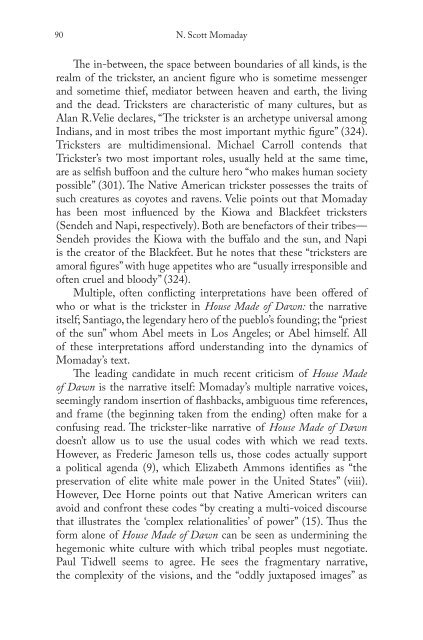Blooms Literary Themes - THE TRICKSTER.pdf - ymerleksi - home
Blooms Literary Themes - THE TRICKSTER.pdf - ymerleksi - home
Blooms Literary Themes - THE TRICKSTER.pdf - ymerleksi - home
Create successful ePaper yourself
Turn your PDF publications into a flip-book with our unique Google optimized e-Paper software.
90<br />
N. Scott Momaday<br />
Th e in-between, the space between boundaries of all kinds, is the<br />
realm of the trickster, an ancient fi gure who is sometime messenger<br />
and sometime thief, mediator between heaven and earth, the living<br />
and the dead. Tricksters are characteristic of many cultures, but as<br />
Alan R.Velie declares, “Th e trickster is an archetype universal among<br />
Indians, and in most tribes the most important mythic fi gure” (324).<br />
Tricksters are multidimensional. Michael Carroll contends that<br />
Trickster’s two most important roles, usually held at the same time,<br />
are as selfi sh buff oon and the culture hero “who makes human society<br />
possible” (301). Th e Native American trickster possesses the traits of<br />
such creatures as coyotes and ravens. Velie points out that Momaday<br />
has been most infl uenced by the Kiowa and Blackfeet tricksters<br />
(Sendeh and Napi, respectively). Both are benefactors of their tribes—<br />
Sendeh provides the Kiowa with the buff alo and the sun, and Napi<br />
is the creator of the Blackfeet. But he notes that these “tricksters are<br />
amoral fi gures” with huge appetites who are “usually irresponsible and<br />
often cruel and bloody” (324).<br />
Multiple, often confl icting interpretations have been off ered of<br />
who or what is the trickster in House Made of Dawn: the narrative<br />
itself; Santiago, the legendary hero of the pueblo’s founding; the “priest<br />
of the sun” whom Abel meets in Los Angeles; or Abel himself. All<br />
of these interpretations aff ord understanding into the dynamics of<br />
Momaday’s text.<br />
Th e leading candidate in much recent criticism of House Made<br />
of Dawn is the narrative itself: Momaday’s multiple narrative voices,<br />
seemingly random insertion of fl ashbacks, ambiguous time references,<br />
and frame (the beginning taken from the ending) often make for a<br />
confusing read. Th e trickster-like narrative of House Made of Dawn<br />
doesn’t allow us to use the usual codes with which we read texts.<br />
However, as Frederic Jameson tells us, those codes actually support<br />
a political agenda (9), which Elizabeth Ammons identifi es as “the<br />
preservation of elite white male power in the United States” (viii).<br />
However, Dee Horne points out that Native American writers can<br />
avoid and confront these codes “by creating a multi-voiced discourse<br />
that illustrates the ‘complex relationalities’ of power” (15). Th us the<br />
form alone of House Made of Dawn can be seen as undermining the<br />
hegemonic white culture with which tribal peoples must negotiate.<br />
Paul Tidwell seems to agree. He sees the fragmentary narrative,<br />
the complexity of the visions, and the “oddly juxtaposed images” as

















